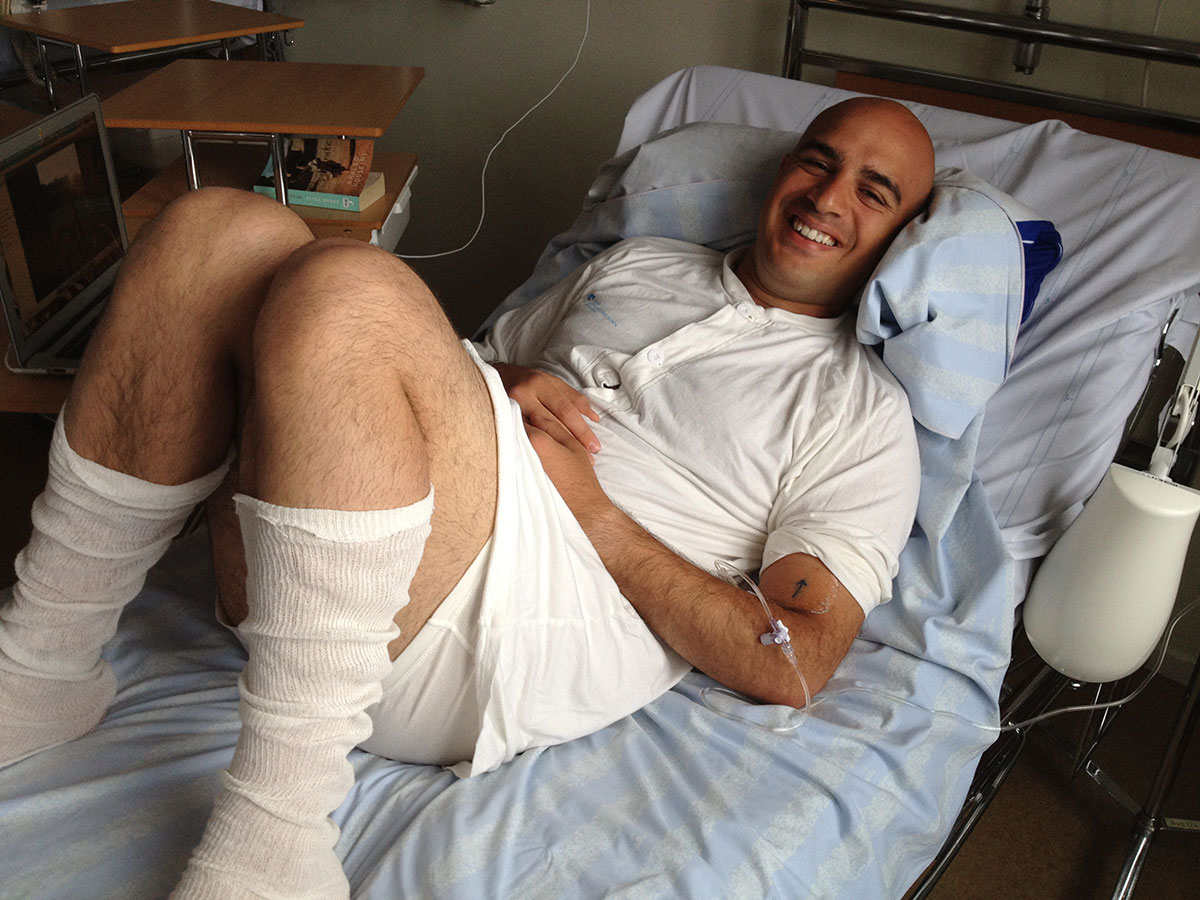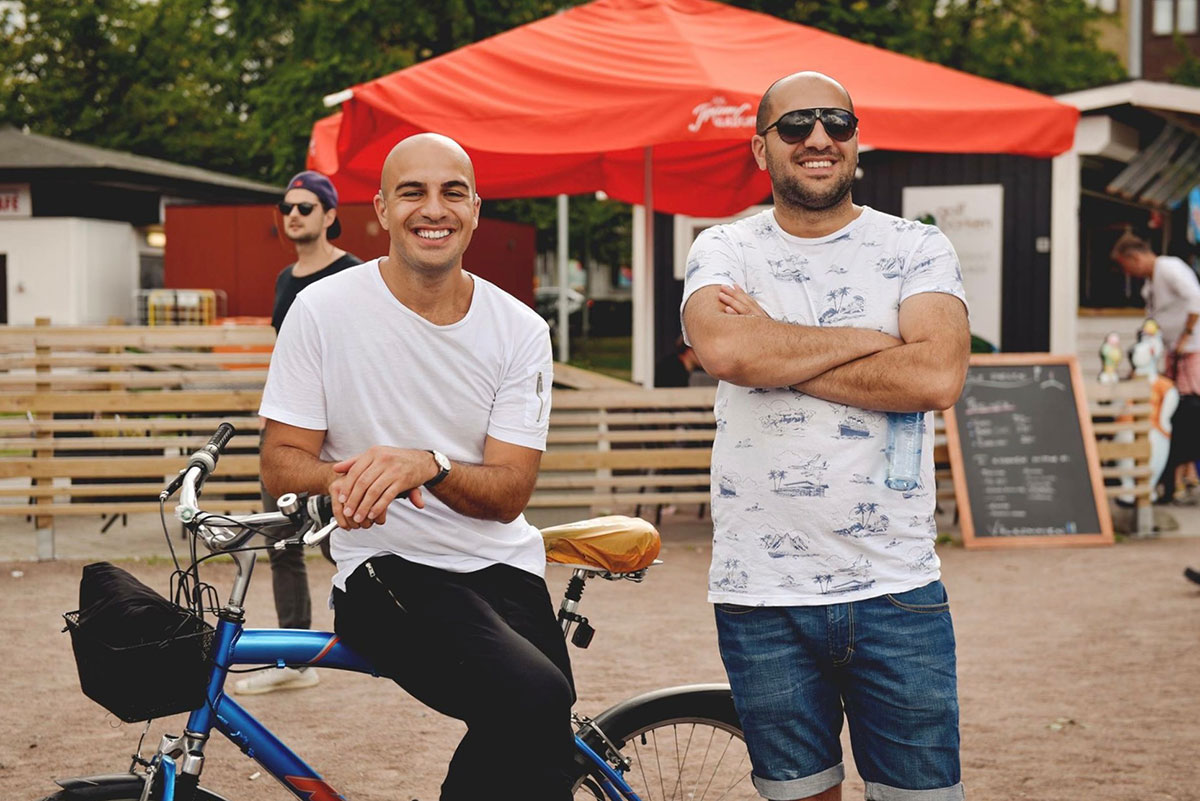Waking up in silence
If Jacob Johanen’s life was a play, this would be the third act. His journey through pain and turmoil, doubt and disease resulted in self-discovery and contentment, and it was made possible by a strong will and some amazing, if tiny, technology.
Act I – A beginning like any other
Born in Gothenburg in 1984, Jacob Johanen had a typical childhood. He was fearless, mischievous and energetic with a big family and lots of friends.
“I was always interacting with people,” says Johanen. “Being with friends and family, having fun, communicating, those were the most important things in my life.”
And so it was that by 19 years old he was ready to take on the world. Johanen had two weeks left in high school, he had a job, established social life and was desperately in love. That’s when tragedy unexpectedly came knocking at his door.
Act II – The bad times
On a morning like any other, Johanen awoke with back pain. It was severe enough that his father, who had suffered similar discomfort due to kidney stones, suggested he visit a health clinic. He was diagnosed with a urinary tract infection, given antibiotics, and sent home.
Later that day, en route to pick up his girlfriend from the gym, Johanen started feeling dizzy. His world started to shake and by the time his girlfriend met him by his car he was in bad shape. The dizziness and spinning sensation caused him to vomit.
“I went back to the health clinic, but the doctors didn’t know what was wrong, so I was told to go home again and see how I felt in the morning,” he says.
That night, Johanen woke to a high piercing noise like a loud signal or alarm. It was so pervasive he went looking around the house for its source. The dizziness had persisted, so when his mother awoke and saw him stumbling around and confused, she didn’t understand what was happening.
“She asked me what I was doing and I asked her where the loud noise was coming from,” he says. “She said, ‘what noise?’ and it was then I knew something was very wrong with me.”
More hospital visits and more tests revealed nothing, and every day for the next two weeks the piercing sound gout louder while his ability to hear worsened. Frustrated and growing increasingly alarmed, Johanen wanted answers; what he got was a condition that seemed to be in rapid decline. One night shortly after, when his mother came to comfort him, he tried to speak to her and realized he could no longer hear himself or her.
“I remember feeling like a child again, sobbing in my mother’s arms,” says Johanen. “I stand almost 30 centimetres taller than her, but there she was holding me while I cried uncontrollably like a baby.”
Over the next few weeks he actually got worse. His eyes became extremely inflamed, causing pain and increased blurred vision. Some of his hearing returned, but so little that he could barely hear anyone, even with the help of a hearing aid. Still, this little improvement boosted his spirits.
“It was like being very wealthy, losing it all and then regaining a small fraction of what you originally had,” says Johanen of getting a small amount of hearing back. “I was thankful, but still sad and depressed.”
The three major symptoms of having dizziness, recurrent eye inflammation and hearing loss after tinnitus may have been daily torture for Johanen, but it was the combination of the three that helped doctors finally diagnose him with Cogan syndrome, a very rare rheumatic disorder that can lead to deafness, and in some cases blindness or even death.
“When they told me it was Cogan syndrome, I was ecstatic,” he says. “Until I found out there was no way cure. I mistakenly thought that once we found out what it was we could fix it, but that was not the case.”
It was, however, the last straw. Cogan syndrome had broken him. He lay in his darkened room with no music, no TV or movies to distract him (the light hurt his eyes too much), afraid to stand up and feeling sorry for himself. His girlfriend even broke up with him. With no social life or hope for change, Johanen went to a very dark place.
“My mother really helped me get out of that hole,” he says. “She helped me to get up the courage to rely on myself and fight this thing.”
 Strangely, a year after the debut of the disease, the inflammation levels normalized. He didn’t get his senses all the way back, but they were manageable. His hearing was bad, but consistently bad. His eyes regressed, but he could see.
Strangely, a year after the debut of the disease, the inflammation levels normalized. He didn’t get his senses all the way back, but they were manageable. His hearing was bad, but consistently bad. His eyes regressed, but he could see.
“I started trying to do more,” Johanen says. “On days that my balance was ok, I tried being more active. I changed my diet and established an active routine. Things were still bad, but at least I was back in control of my life. I was never going to give up. My goal was to get back to the person I was.”
Over the next eight years, Johanen learned to live with his condition, re-establishing a social life, working, and even meeting the woman that would eventually be his wife. The existential questions that arose in him because of Cogan’s matured him early, and now with his evolved value system and appreciation of what his life was, he had he moved on. He had an extra job and was studying to become a social worker. He still lived in fear that his condition might worsen at any time, but he prepared for the worst. He even learned some sign language. Right around that time, he lost what little hearing he had completely.
“One day my hearing aid just stopped working,” he says. “This brought back all the bad feelings from before. It felt like everything I had achieved would be lost.”
Act III – Living on the other side
Unlike before, Johanen was ready to fight this time. One doctor recommended a cochlear implant, which is a device that stimulates the damaged portions of the inner ear to deliver sound signals to the brain. It uses high-grade, ultra-fine wires, like the Exera® wire from Alleima.
 “The electrode array of wires that is used in cochlear implants to actually stimulate the organ is made from these ultra-fine wires,” says Gary Davies, Manager at Alleima's medical wire business in Palm Coast, Florida.
“The electrode array of wires that is used in cochlear implants to actually stimulate the organ is made from these ultra-fine wires,” says Gary Davies, Manager at Alleima's medical wire business in Palm Coast, Florida.
Johanen was sceptical but intrigued. It seemed too good to be true. After a successful operation the device was activated a few weeks later.
“This was a day I’ll never forget,” he says. “My mother, wife and sister sat beside be and the audiologist was across the desk. When they activated it, I could hear sounds I hadn’t heard in ages. It was so sweet, this quiet sound. Like paper swishing in air. It was an artificial sound, because it takes a few weeks for the brain to adapt to the signals. But after a few minutes, I could hear the audiologist speak, and my mother and my wife cried, and I laughed. It was a feeling of overwhelming joy and relief.”
For Johanen, this is the part of the journey is sweet. He relishes his life, his family, his job as a social worker. And while it isn’t perfect, it is his.
“Every morning, I wake up in silence before I turn on my implant,” he says. “So, I am reminded every day about how lucky I am to have what I have. My quality of life would not be where it is without it.
“When people ask me if I could go back and change what happened to me, I say I don’t know. Maybe this was my purpose, to climb this ladder to become the man I’ve become and help others, because now I know that nothing can stop you if you believe in yourself.”
Facts about Disabling hearing loss
Over five percent of the world’s population live with disabling hearing loss.
Disabling hearing loss refers to hearing loss greater than 40 decibels (dB) in the better hearing ear in adults and a hearing loss greater than 30 dB in children.
Unless action is taken, the World Health Organisation (WHO) reports that 630 million people will live with disabling hearing loss by 2030.
Current estimates suggest an 83 percent gap in hearing aid need and use — only 17 percent of those who could benefit from the use of a hearing aid actually use one.
Cochlear implants can restore hearing in people with severe hearing loss who are no longer helped by using hearing aids.
Unlike hearing aids, which amplify sound, cochlear implants stimulate the auditory nerves via the cochlear organ directly without passing through the damaged portions of the ear and sound is perceived
Exera® fine medical wire from Alleima is used to help treat hearing disorders by stimulating the nerves in cochlear and middle ear implants as well as stimulating acoustic signals in bone conduction systems.
The implanted electrode array wire used in cochlear implants is made using alloys of platinum and iridium and encased within the silicone.
Cochlear implants
A cochlear implant hearing system includes a microphone and speech processor that sits outside of the body.
The processor conveys a signal to the implant located under the skin.
The electronics package contained in the implant sends a digital signal to the electrode array wires.
The pads attached to the electrode array wires stimulate and move fluid in the cochlea organ, which sends signals to the auditory nerve.
The message then goes to the brain, which uses the information to recognize sounds and understand speech.